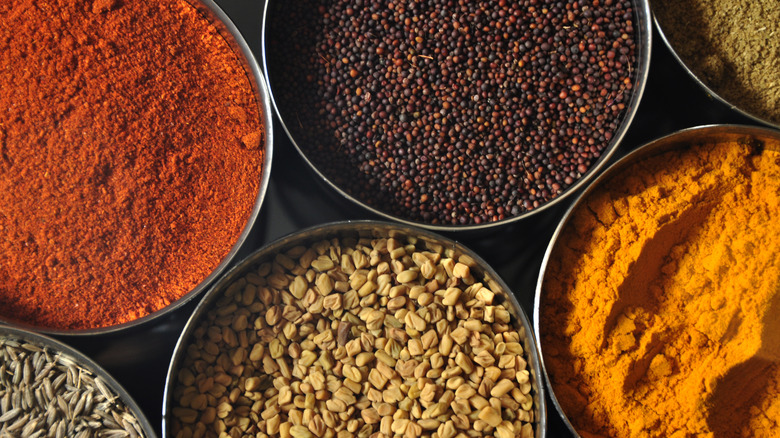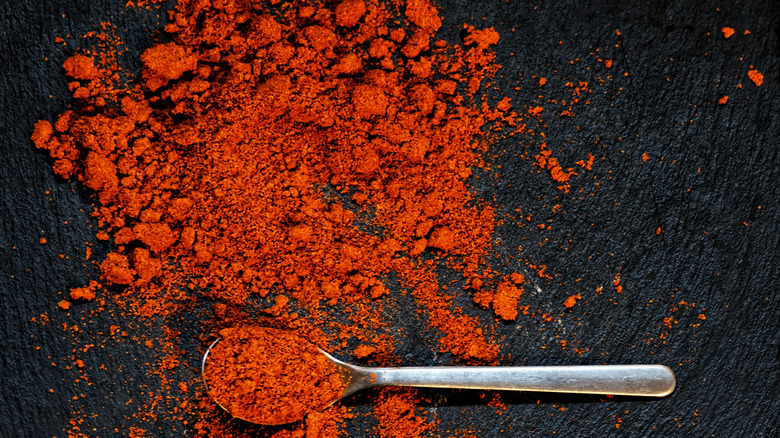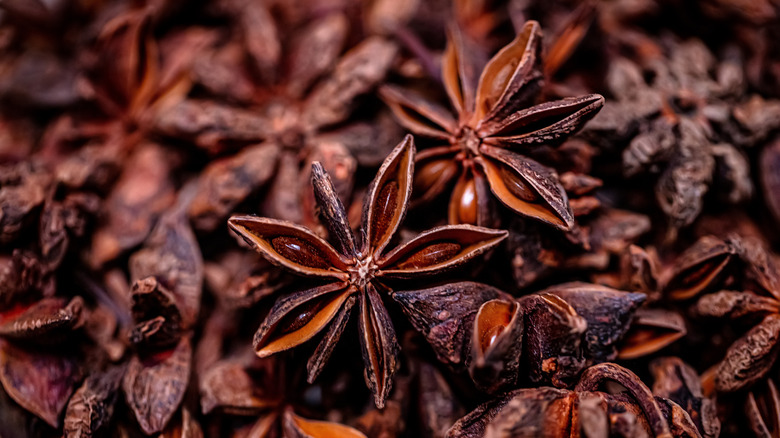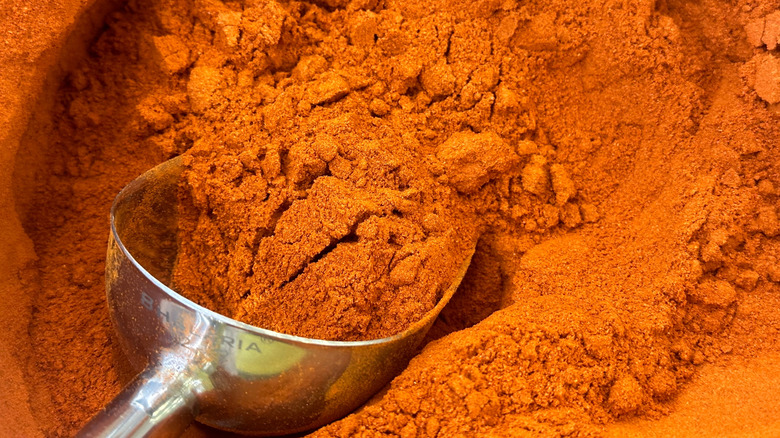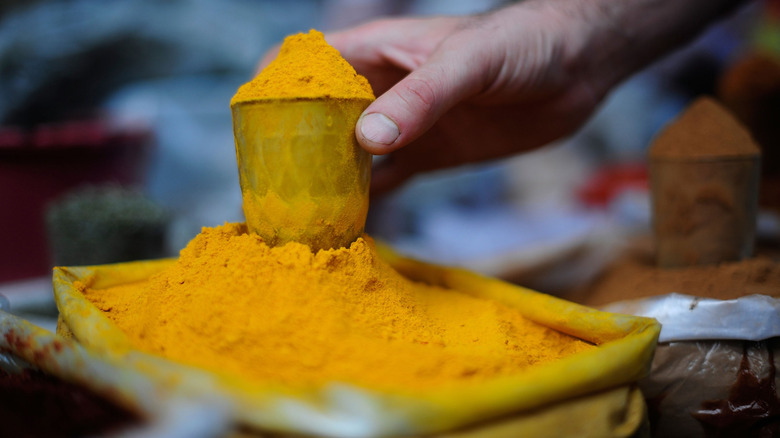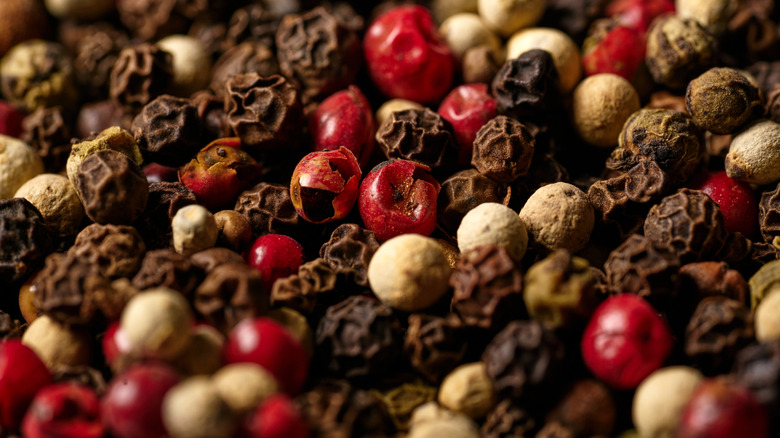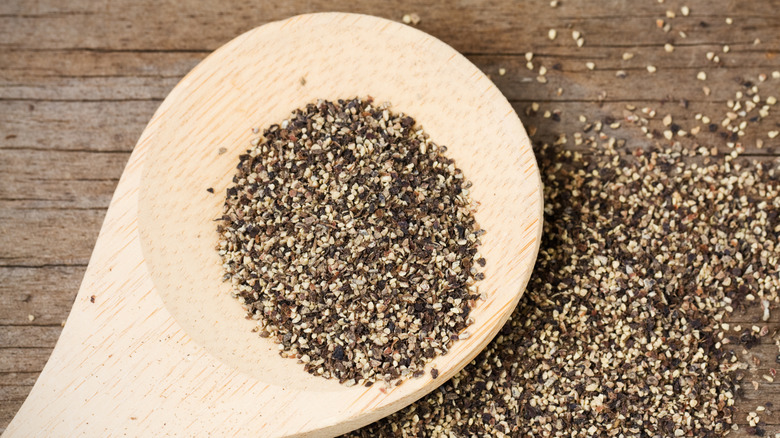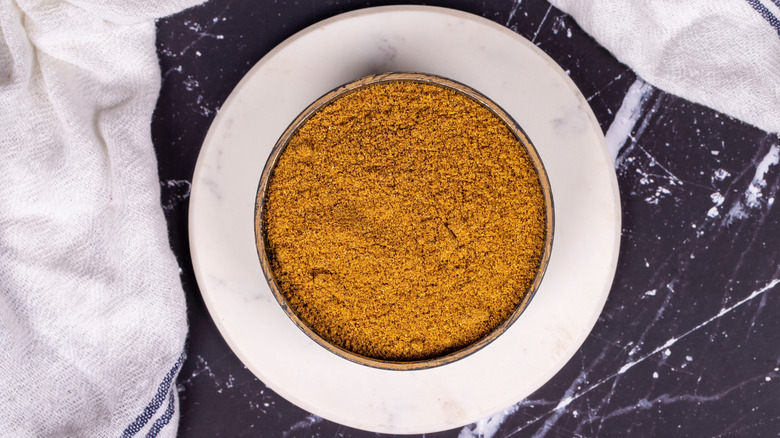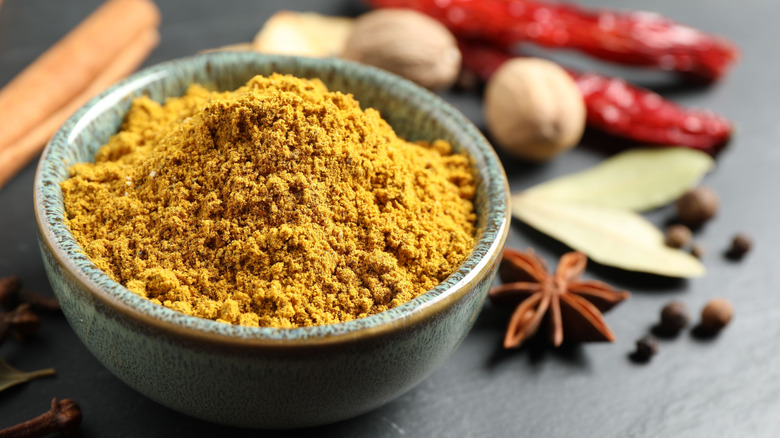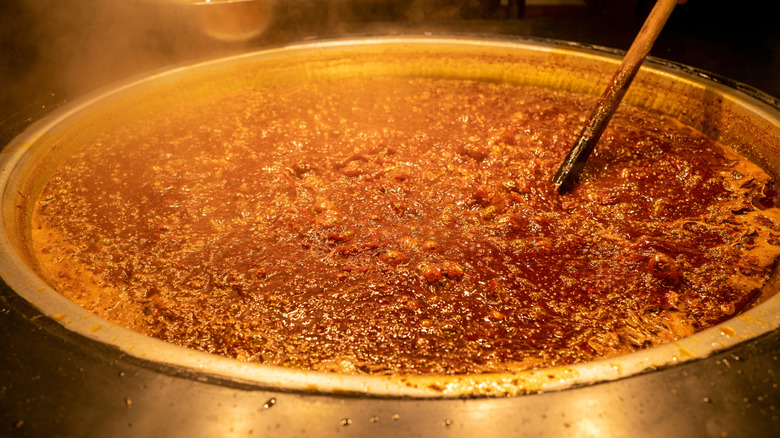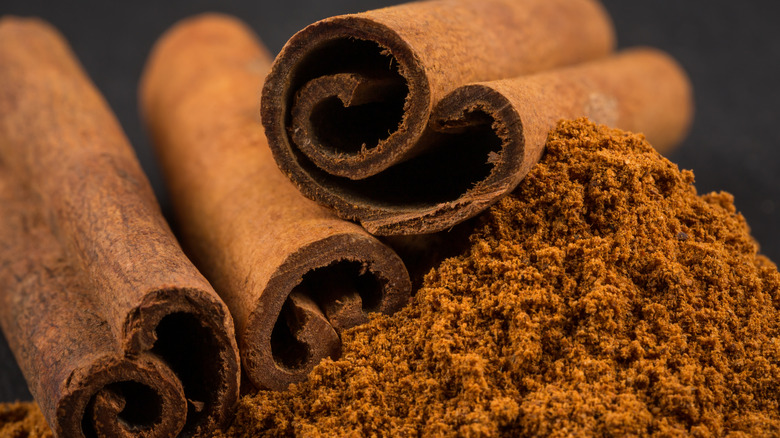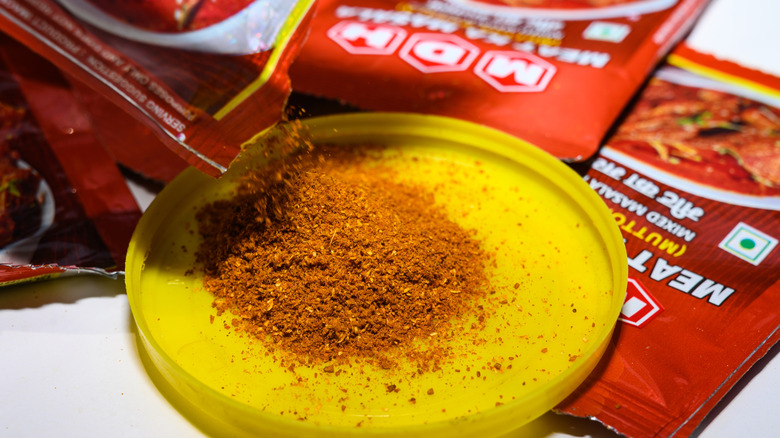10 Of The Biggest Seasoning Recalls In History
While foodborne illnesses have existed as long as humans have, the history of food recalls is fairly recent. In the US, it wasn't until the 1970s that the FDA really began investigating contaminated foods, though it has taken many years since then to more effectively track, enforce, and distinguish between different recall classes. There is little recorded before 1973, as this was the year the CDC initiated the Foodborne Disease Outbreak Surveillance System (FDOSS). Since that time, food safety measures have only continued to improve. In the case of spices and seasonings, more regulated testing for bacteria and other contaminants has become common practice.
While the expiration dates on spices are typically pretty long, their long shelf life has often contributed to the widespread impact of some of the biggest seasoning recalls. Tainted spices also jeopardize all products — like snack foods and prepared meals — that have been seasoned with them. The industrialized nature of today's food production and the international supply chain of imported spices have led to some significant health concerns, from Salmonella poisoning to serious allergic reactions. This list discusses the scope of 10 of the biggest seasoning recalls since 1973, and their varying causes.
1. Germany recalled paprika in 1993 after largest recorded case of Salmonella poisoning
In 1993, Germany experienced the world's "largest documented outbreak due to contaminated spices," according to Epidemiology and Infection. Children under the age of 14 made up the demographic most affected by this upsurge, which reached its height at 1,000 reported cases of Salmonella poisoning.
This influx in cases was traced to contaminated paprika powder sourced from South America, which was used as part of the seasoning for paprika-flavored potato chips. As a result, these products faced a nationwide recall. If there were hospitalizations tied to this incident, they were not reported. But the adverse effects of the tainted spices revealed that even trace amounts of bacteria within them could pose discernible health risks. As Epidemiology and Infection's study concluded, "the results suggest that even a low level of Salmonella contamination is not acceptable in food products ready for consumption."
2. The USA recalled all star anise teas in 2003
In 2003, the US recalled all star anise teas, tracing the spice as the source of some detrimental health problems. Tea made from star anise has been used to help with colic in children, which might explain why infants were a demographic largely affected by this seasoning. While only 40 cases were reported, the consequences for consuming the contaminated star anise were notably extreme. The FDA deemed any sort of tea brewed from the spice to be unsafe because of the reported side effects, which "ranged from serious neurological effects, such as seizures, to vomiting, jitteriness and rapid eye movement."
The reason behind star anise suddenly inciting serious health issues is believed to have been a mix-up between two varieties of the seasoning. Chinese star anise is the common type sold as a household spice and known to be safe to consume, whereas Japanese star anise can be highly toxic. Consumers were encouraged not to ingest any products with the spice until the FDA could monitor imports to ensure they would be safe. Though the stats were not included, the FDA also revealed that this recall existed on an international scale. Three other countries — France, Spain, and the Netherlands — reported similar health concerns linked to the same spice.
3. The UK recalled 600 products containing chili powder in 2005
In 2005, the UK enacted a mass recall on Worcestershire sauce and Worcestershire seasoned products due to the ingredients containing a chili powder contaminated with the food colorant, Sudan 1 dye. While there were no reports of illnesses, Sudan 1 is a potentially carcinogenic red dye commonly used as a colorant for solvents and shoe polish, which Britain had banned for human consumption well before it was detected in this seasoning crisis. Traced back to a shipment of Indian chili powder from 2002, the discovery of this contaminant revealed the additional unsettling truth that British citizens had long since been consuming adulterated products before the 2005 recall took place.
Since Worcestershire is such a prevalent ingredient in British cuisine, the recall on foodstuffs contaminated with Sudan 1 dyed chili powder went far beyond mere bottles of the sauce. Commonly used to season chips, sausages, and prepared meals, this bad batch of Worcestershire sauce impacted nearly 600 products. Becoming Britain's largest food recall on record, the financial losses totaled about 100 million pounds.
4. Four European countries recalled curry products in 2009
Though not as dramatic as the red dye scare across the UK, a similar instance occurred throughout Europe a few years later, leading to a recall on a different, potentially carcinogenic dye — methyl yellow. In 2009, Belgium, France, Luxembourg, and Germany recalled a variety of curry products that contained a Belgian-imported curry powder from India contaminated with this color additive. This recall impacted a considerable number of products beyond the powder, such as curry pastes and prepared curries, including products that were already on store shelves as well as still in production.
Methyl yellow, also called butter yellow, is known to cause adverse effects after repeated exposure. In addition to the dye being a likely carcinogen, health concerns, as the Encyclopedia of Toxicology reports, range from liver dysfunction to reproductive issues. Europe's 2009 recall on curry products did not publicize any cases of adverse effects amongst consumers, but was prompt and thorough in eliminating food items that contained this harmful colorant.
5. The US recalled over 100,000 pounds of pepper in 2010
Between 2009 and 2010, the outbreak of 272 cases of Salmonella poisoning across the US became a cause for concern. An study in Epidemiology and Infection states that 26% of these cases resulted in hospitalizations. While no deaths were reported, the outbreak prompted a thorough analysis that revealed salami products to be behind the outbreak, though the source of the Salmonella would later prove to be an ingredient in the salami seasoning. The CDC reports that the company responsible, Daniele International Inc., recalled 1.3 million pounds of salami product in January 2010, followed by 17,000 additional pounds recalled later that same month, and a third recall on 115,000 pounds the following month.
As the CDC mentions, this Salmonella outbreak led to further investigation between the FSIS, FDA, and the Rhode Island Department of Health. These agencies' findings revealed that it was actually the pepper used to season the salami products that was the source of the Salmonella contamination, which had been added as a raw ingredient after the meat was fermented and dried. As a result, the two pepper companies responsible recalled 53,000 pounds of crushed red pepper and 55,000 pounds of black pepper, respectively. Twelve further recalls occurred afterwards for other companies that had received pepper from the same sources.
6. One brand recalled 91,000 units of pepper in North America in 2014
Due to another instance of pepper contaminated with Salmonella in 2014, Frontier Co-op, an organic wholesaler, recalled many of its pepper products in all 50 US states and parts of Canada. According to the database Recall.Report, the company recalled as many as 91,357 units of pepper that had been distributed among numerous brands, including Frontier, Whole Foods Market 365, and Simply Organic.
The Indiana State Department of Health reported that the pepper had not been associated with an outbreak of illness due to bacterial contamination; the recall occurred as a precautionary measure because a random test identified that Salmonella might still be present. This incident prompted Frontier Co-op to commit to added safety precautions within its supply chain in hopes of preventing future health concerns. The recall also revealed the importance of continual testing to ensure seasonings do not become contaminated at any point before reaching consumers.
7. 500,000 pounds of cumin was recalled from Turkey in 2015
Cumin, a truly ancient spice, has seen a number of recalls in recent history. In 2015, there was one of the largest due to high and undeclared amounts of peanut protein found mixed into the spice. The origin of this adulterated ground cumin proved difficult to pinpoint. Though it came from Turkish suppliers, there was mystery surrounding where exactly the cumin was sourced from.
The contaminated spice led to a recall of 500,000 pounds from 700 different food products, including taco mixes and prepared meals. The recall impacted so many foodstuffs that it led to the destruction of millions of dollars of products. What was most alarming about the 2015 cumin recall, however, was that the levels of peanut protein were far higher than normal cross-contamination could allow for. As Allergic Living divulged, some of the affected seasoning contained as much as 5 to 10% peanut. These unusually high percentages led to reports of allergic reactions, and have cultivated a strong suspicion that the spice was intentionally contaminated. The incentive for such adulteration remains a mystery, but this crisis made the FDA aware of the hazards of cross-contamination, inciting a need for increased standards and testing measures that could prevent further recalls of such magnitude.
8. A Florida company recalled 188.5 tons of curry seasoning in 2016
In 2016, the Miami-based Oriental Packaging Co. recalled a substantial amount of curry seasoning when testing revealed the spice was contaminated with lead. According to Food Safety News, the New York State Health Department discovered the lead content during routine sampling, which spurred a recall on five brands of curry seasoning and a total of 188.5 tons of product.
The source of the lead contamination was difficult to track, as curry spice mixtures include ingredients like ginger and turmeric, which are roots that might absorb it from the ground or via the water used during the growing process. But, as a study in Public Health Reports reveals, "Lead is generally insoluble in soil and poorly absorbed by plants." Whether or not this was the source of contamination for the 2016 recall, lead chromate has been discovered as a not uncommon additive in turmeric from India and Bangladesh, as it is naturally bright yellow and used to enhance spices' color and overall attractiveness.
9. 96,810 pounds of China's Ming Yang Hotpot seasoning were recalled in 2021
In 2021, the California-based company GLG Trading Inc. recalled 96,810 pounds of seasoning products made with beef tallow. This recall pertained to three varieties of Ming Yang Hotpot seasoning imported from China, which were in violation of the stipulations of the US Department of Agriculture's Food Safety and Inspection Service.
According to the USDA, the People's Republic of China is an "ineligible country for beef" and the FSIS was anonymously notified of these uninspected beef products illegally imported to the US. What followed was a swift recall throughout the six states where the seasonings had been shipped and distributed. There were no reported adverse effects from the vacuum-sealed hotpot products, which lacked the requisite mark of inspection, but it was concerning that they found a way to circumnavigate federal requirements in order to reach consumers. This seasoning recall reinforced the importance of inspection on international imports.
10. Testing urged a recall on a dozen cinnamon brands in 2024
The ground cinnamon recall in 2024 reflects increased vigilance after a series of recalls on cinnamon products in 2023 due to elevated levels of lead. This initial discovery was traced to three brands of cinnamon applesauce pouches, which had lead levels high enough to cause nearly 500 plausibly linked cases of lead poisoning in children, most under six years old. The FDA's investigations suspect that the contaminant may have been intentionally added to enhance the applesauce product's economic value.
This alarming incident prompted further inspection on other sources of ground cinnamon. As testing continues, the FDA has recalled a handful of brands due to their elevated lead content. But a separate inspection by Consumer Reports, a nonprofit dedicated to independent product testing, found some alarming results that urge consumers to avoid at least a dozen additional cinnamon brands. According to James Rogers, PhD, Director of Food Safety Research and Testing at CR, "Just a quarter teaspoon of any of those products has more lead than you should consume in an entire day." Since it remains among the spices best purchased pre-ground, it would be prudent to choose ground cinnamon carefully until the absence of widespread lead contamination has been confirmed.
11. Two Indian spice brands have been recalled internationally in 2024
In early 2024, both Hong Kong and Singapore recalled four spice mixes from two Indian spice brands, MDH and Everest. The mixes in question are MDH's Madras curry powder, mixed Masala powder, and Sambhar masala, as well as Everest's fish curry Masala. All four seasonings have been found to contain ethylene oxide, a potentially cancer-causing pesticide that is said to cause no harm if consumed in small amounts, and authorized in some countries for use in food sterilization to prevent the growth of bacteria. Perhaps there is a correlation with heightened ethylene oxide levels and the fact that Everest faced a recall on numerous seasonings in 2023 for Salmonella contamination.
Newsweek reports that the US permits low concentrations of ethylene oxide in food, though the FDA is still investigating the potential presence of this carcinogen in MDH and Everest spice blends. Australia and New Zealand are also looking into the toxicity of these brands, while India conducts its own inspections. This recall and its subsequent investigations have reiterated the alarming scope of contaminated food products destined for international export.
